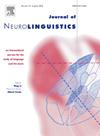Attention to L2 morpho-syntactic form across visual and aural modalities and the modulation of working memory: ERP evidence
IF 1.2
3区 心理学
Q2 LINGUISTICS
引用次数: 0
Abstract
The allocation of L2 learners’ attention to meaning and form across visual and aural modalities has been a critical area of research for decades. However, there is ongoing debate about whether L2 learners struggle to attend to both meaning and form simultaneously in the aural modality. This study investigates how L2 learners process morpho-syntactic form across these modalities when asked to read or listen for comprehension, and examines the modulatory role of working memory (WM). Thirty-four Chinese L2 learners of English with intermediate-high L2 proficiency completed story listening and reading comprehension tasks while ERP data was recorded, time-locked to the onset of the progressive marker “-ing”. Participants were unaware of 40 correct and 40 omitted uses of the marker. They also completed tasks assessing executive, phonological, and visuospatial WM. Linear mixed-effects models revealed that: (1) In the visual modality, syntactic violations elicited larger anterior negativity (AN) than correct forms within 300–500 ms and 500–800 ms, while in the aural modality, syntactic violations did not induce significant changes in ERP deflections compared with correct forms in the same time windows; (2) A significant interaction between Syntactic Correctness, executive WM and visuospatial WM was found only in the visual modality within 300–500ms. While Participants with high executive WM showed early ERP responses to syntactic violations, participants with low executive WM showed similar patterns only when their visuospatial WM was high. These findings suggest that L2 learners could attend to form in the visual modality, whereas such sensitivity may be less observable in the aural modality under the present experimental conditions. Moreover, visuospatial WM and executive WM interactively influence the early detection of morpho-syntactic features in the visual input.
跨视觉和听觉模态对第二语言形态句法形式的注意与工作记忆的调节:ERP证据
二语学习者在视觉和听觉模式下对意义和形式的注意力分配一直是几十年来研究的一个关键领域。然而,关于二语学习者是否在听觉模态中努力同时注意意义和形式,一直存在争论。本研究探讨了二语学习者在阅读或听力理解时如何处理这些形态-句法形式,并考察了工作记忆(WM)的调节作用。34名具有中高水平英语水平的中国第二语言学习者完成了故事听力和阅读理解任务,同时记录了ERP数据,时间锁定在进行标记“-ing”的开始。参与者不知道标记的40种正确用法和40种省略用法。他们还完成了评估执行、语音和视觉空间WM的任务。线性混合效应模型显示:(1)在视觉模态中,在300-500 ms和500-800 ms内,句法违犯比正确模态诱发了更大的前向负性(AN),而在听觉模态中,在相同的时间窗内,句法违犯比正确模态诱发的ERP偏转没有显著变化;(2)句法正确性、执行WM和视觉空间WM之间的交互作用仅在300-500ms的视觉情态中存在。高执行力WM的参与者对语法错误有早期的ERP反应,而低执行力WM的参与者只有在他们的视觉空间WM高时才表现出类似的模式。这些发现表明,在目前的实验条件下,二语学习者在视觉模态下可以注意到形式,而在听觉模态下这种敏感性可能不太明显。此外,视觉空间WM和执行WM交互影响视觉输入中形态句法特征的早期检测。
本文章由计算机程序翻译,如有差异,请以英文原文为准。
求助全文
约1分钟内获得全文
求助全文
来源期刊

Journal of Neurolinguistics
医学-神经科学
CiteScore
3.90
自引率
5.00%
发文量
49
审稿时长
17.2 weeks
期刊介绍:
The Journal of Neurolinguistics is an international forum for the integration of the neurosciences and language sciences. JNL provides for rapid publication of novel, peer-reviewed research into the interaction between language, communication and brain processes. The focus is on rigorous studies of an empirical or theoretical nature and which make an original contribution to our knowledge about the involvement of the nervous system in communication and its breakdowns. Contributions from neurology, communication disorders, linguistics, neuropsychology and cognitive science in general are welcome. Published articles will typically address issues relating some aspect of language or speech function to its neurological substrates with clear theoretical import. Interdisciplinary work on any aspect of the biological foundations of language and its disorders resulting from brain damage is encouraged. Studies of normal subjects, with clear reference to brain functions, are appropriate. Group-studies on well defined samples and case studies with well documented lesion or nervous system dysfunction are acceptable. The journal is open to empirical reports and review articles. Special issues on aspects of the relation between language and the structure and function of the nervous system are also welcome.
 求助内容:
求助内容: 应助结果提醒方式:
应助结果提醒方式:


